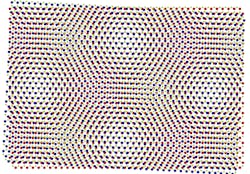2D semiconductor 'Moiré crystal' may contain thousands of single-photon emitters
Single-photon emitters are essential for photonics-based quantum information technology, including quantum computing and quantum cryptography. Now, researchers led by University of Texas at Austin physics professor Xiaoqin Elaine Li have created a material that could have thousands of single-photon emitters naturally positioned within it.1
By stacking two different semiconductor bilayers (here, molybdenum diselenide/tungsten diselenide, or MoSe2/WSe2) on top of each other and slightly rotating them relative to each other, the scientists created an artificial crystal with a regularly spaced pattern of atoms. Such a pattern is known as a moiré crystal, which localizes electrons into a tight space on the order of a nanometer.
The new material absorbs energy from photons and emits new photons in such a way that the researchers interpret the material to contain thousands of identical single-photon emitters. If confirmed, the novel light source could be used in quantum information systems. Other researchers have created single-photon emitters, but no previous technology has produced an array of thousands of identical ones.
"This is a longstanding goal in quantum information science that has never been demonstrated before," Li says. "Our studies suggest that this goal may be achievable in this new material."
The researchers have strong experimental and theoretical evidence that their new material forms a checkerboard array of thousands of single-photon emitters, but the resolution of their equipment has not yet allowed them to prove it conclusively. As next steps, Li and her team will collaborate with other researchers to verify that they are, in fact, forming single-photon emitters, while continuing to improve the material's quality.
The paper's co-first authors are Kha Tran, a physics graduate student at UT Austin, and Galan Moody, a physicist at the National Institute of Standards and Technology and former UT Austin postdoctoral fellow. Other key contributors at UT Austin are Allan MacDonald, professor of physics; Emanuel Tutuc, professor of engineering; Nanshu Lu, associate professor of electrical engineering; and Sanjay K. Banerjee, professor of engineering.
Source: https://cns.utexas.edu/news/new-material-holds-promise-for-more-secure-computing
REFERENCE:
1. Kha Tran et al., Nature (2019); https://doi.org/10.1038/s41586-019-0975-z.

John Wallace | Senior Technical Editor (1998-2022)
John Wallace was with Laser Focus World for nearly 25 years, retiring in late June 2022. He obtained a bachelor's degree in mechanical engineering and physics at Rutgers University and a master's in optical engineering at the University of Rochester. Before becoming an editor, John worked as an engineer at RCA, Exxon, Eastman Kodak, and GCA Corporation.
